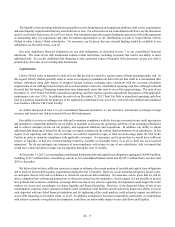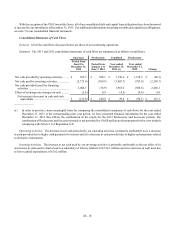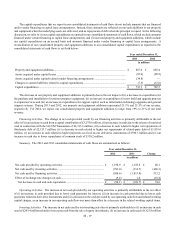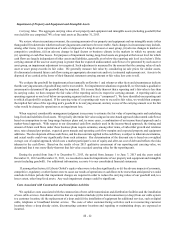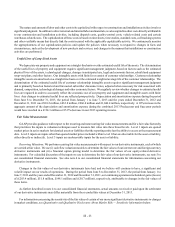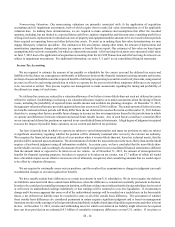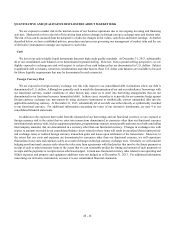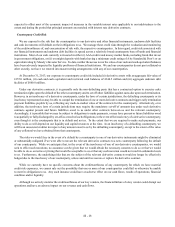Virgin Media 2013 Annual Report Download - page 137
Download and view the complete annual report
Please find page 137 of the 2013 Virgin Media annual report below. You can navigate through the pages in the report by either clicking on the pages listed below, or by using the keyword search tool below to find specific information within the annual report.
III - 27
The relationship between (i) the euro and the U.S. dollar and (ii) the pound sterling, which is our reporting currency, is shown
below, per one pound sterling:
As of December 31,
2013 2012
Spot rates:
Euro................................................................................................................................................... 1.2014 1.226
U.S. dollar ......................................................................................................................................... 1.6567 1.6189
Year ended December 31,
2013 2012 2011
Average rates:
Euro............................................................................................................................ 1.1776 1.2326 1.1521
U.S. dollar.................................................................................................................. 1.5644 1.5852 1.6038
Inflation Risk
We are subject to inflationary pressures with respect to labor, programming and other costs. While we attempt to increase
our revenue to offset increases in costs, there is no assurance that we will be able to do so. Therefore, costs could rise faster than
associated revenue, thereby resulting in a negative impact on our operating results, cash flows and liquidity. The economic
environment in the U.K. is a function of government, economic, fiscal and monetary policies and various other factors beyond
our control that could lead to inflation. We are unable to predict the extent that price levels might be impacted in future periods
by the current state of the economies in the U.K.
Interest Rate Risks
We are exposed to changes in interest rates primarily as a result of our borrowing and investment activities, which include
fixed-rate and variable-rate investments and borrowings by our operating subsidiaries. Our primary exposure to variable-rate debt
is through our LIBOR-indexed VM Credit Facility.
In general, we seek to enter into derivative instruments to protect against increases in the interest rates on our variable-rate
debt. Accordingly, we have entered into various derivative transactions to reduce exposure to increases in interest rates. We use
interest rate derivative contracts to exchange, at specified intervals, the difference between fixed and variable interest rates calculated
by reference to an agreed-upon notional principal amount. From time to time, we may also use interest rate cap and collar agreements
that lock in a maximum interest rate if variable rates rise, but also allow our company to benefit, to a limited extent in the case of
collars, from declines in market rates. At December 31, 2013, we effectively paid a fixed interest rate on all of our total debt after
considering the impact of our interest rate derivative instruments that convert variable rates to fixed rates. The final maturity dates
of our various portfolios of interest rate derivative instruments generally fall short of the respective maturities of the underlying
variable-rate debt. In this regard, we use judgment to determine the appropriate maturity dates of our portfolios of interest rate
derivative instruments, taking into account the relative costs and benefits of different maturity profiles in light of current and
expected future market conditions, liquidity issues and other factors. For additional information concerning the terms of these
interest rate derivative instruments, see note 4 to our consolidated financial statements.
Weighted Average Variable Interest Rate. At December 31, 2013, our variable-rate indebtedness aggregated £2.7 billion, and
the weighted average interest rate (including margin) on such variable-rate indebtedness was approximately 3.8%, excluding the
effects of interest rate derivative contracts, financing costs, discounts or commitment fees, all of which affect our overall cost of
borrowing. Assuming no change in the amount outstanding, and without giving effect to any interest rate derivative contracts,
financing costs, discounts or commitment fees, a hypothetical 50 basis point (0.50%) increase (decrease) in our weighted average
variable interest rate would increase (decrease) our annual consolidated interest expense and cash outflows by £13.5 million. As
discussed above and in note 4 to our consolidated financial statements, we use interest rate derivative contracts to manage our
exposure to increases in variable interest rates. In this regard, increases in the fair value of these contracts generally would be


